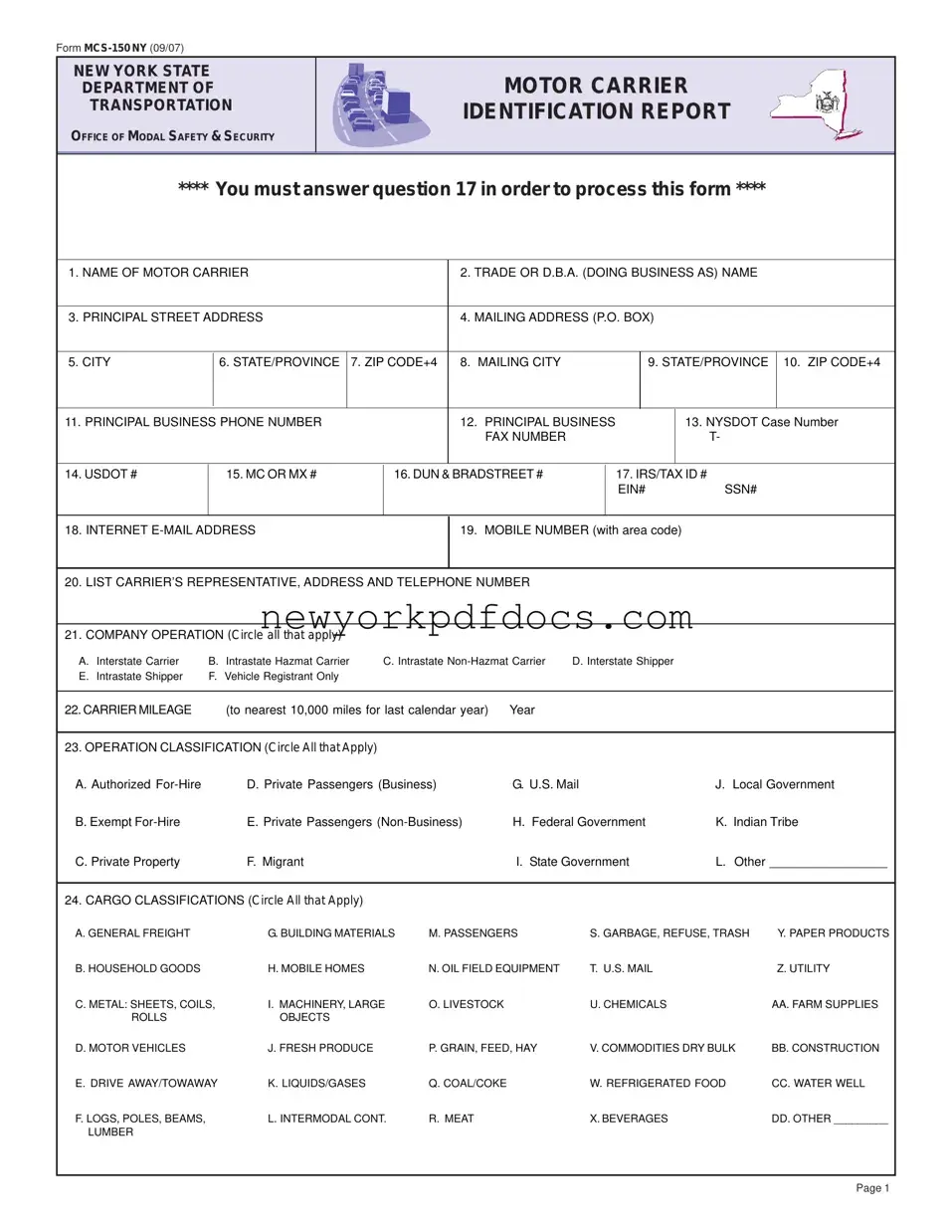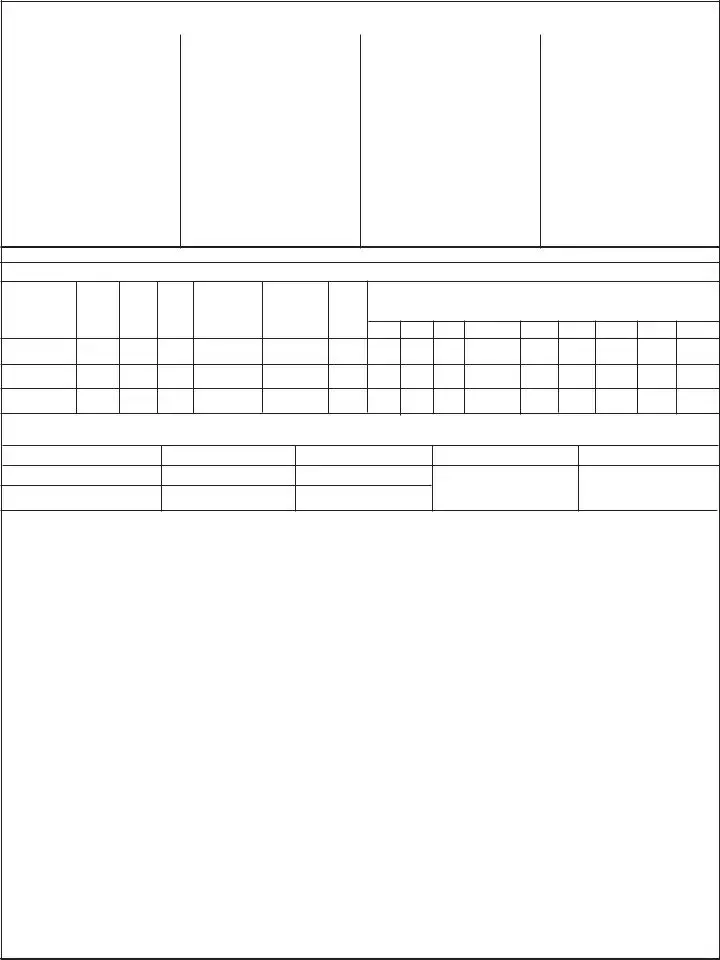INSTRUCTIONS FOR COMPLETING THE MOTOR CARRIER IDENTIFICATION REPORT (MCS-150NY)
(Please Print or Type All Information)
1.Enter the legal name of the business entity (i.e., individual, partnership, corporation or limited liability company) that owns/controls the motor carrier. If the business entity is an individual or partnership with a doing business as (d/b/a) or trade name, attach one copy of the business certificate issued by the County Clerk’s Office. If the business entity is a corporation, limited liability company (LLC) or limited partnership (LP), attach a copy of the filing receipt issued by the New York Secretary of State.
2.If the business entity is operating under a name other than that in Block 1, (i.e., d/b/a or trade name) enter that name. Otherwise, leave blank.
3.Enter the principal place of business, street address, where safety records are kept.
4.Enter mailing address if different from the physical address, otherwise leave blank. Also, applies to #8, #9, & #10.
5.Enter the city where the principal place of business is located.
6.Enter the two-letter postal abbreviation for the State or the name of the Canadian Province corresponding with the physical address.
7.Enter the zip code + 4 number corresponding with the physical street address.
8.Enter the city corresponding with the mailing address.
9.Enter the two-letter postal abbreviation for the State or the name of the Canadian Province corresponding with the mailing address.
10.Enter the zip code + 4 number corresponding with the mailing address
11.Enter the telephone number, including area code, of the principal place of business.
12.Enter the Fax number, including area code, of the principal place of business.
13.Enter the case number (T-number) assigned to the motor carrier for intrastate for-hire operations in New York if already assigned.
14.If the company is not a new applicant, that is, if it already has a USDOT number, enter the company’s USDOT number.
15.If the company has already been assigned an “MC” or “MX” identification number for Interstate FMCSA operating authority, enter the number.
16.Enter your Dun & Bradstreet business number (used as a secondary identifier; if you do not have one, leave blank).
17.Enter either the employer identification number (EIN #) or social security number (SSN #) assigned to the motor carrier operation by the Internal Revenue Service.
18.Enter the e-mail address for the official point of contact, if you have one.
19.Enter the mobile number, including area code, of the business.
20.Enter the name, address, and telephone number of the Motor Carrier’s representative. If there is none, enter N/A.
21.Circle the appropriate type of carrier operation classification.
o Interstate (Carrier/Shipper) -- transportation of persons or property across State Lines, including international boundaries, or wholly within one State as part of a thorough movement that originates or terminates in another State or country.
o Intrastate (Hazmat Carrier, Non-Hazmat Carrier, Shipper) - transportation of property wholly within the boundaries of a single State.
o Vehicle Registrant Only - The company is a Vehicle Registrant Only if its base state of operations requires the company/individual to obtain a USDOT Number as a required part of its state commercial vehicle registration process AND the individual that is listed on the vehicle registration and to whom license plates are issued will never operate the CMV under its own assigned USDOT Number or Operating Authority. Two of the more common reasons to receive a USDOT Number with a “vehicle registrant only” status are illustrated in the examples below. If you select “vehicle registrant only” as the response, do not select any other responses for item 21.
Examples:
o The company owns and registers its commercial trucks for the sole purpose of renting or leasing those trucks to Motor Carriers that will operate the trucks to transport goods.
o The company is an owner-operator that will never operate the trucks under its own USDOT Number or Operating Authority (the company only operates under another company’s USDOT Number or Operating Authority).
NOTE: If the company is a Vehicle Registrant Only, do not select additional company operations. Skip to item 30, sign, and date the form.
22.Enter the total mileage of all commercial motor vehicles in the company’s operation to nearest 10,000 miles for the last calendar year.
23.Circle appropriate classification. Circle all that apply. If “L. Other” is circled, enter the type of operation in the space provided.
Authorized For Hire—transportation for compensation as a common or contract carrier of property, owned by others, or passengers under the provisions of the FMCSA.
Exempt For Hire—transportation for compensation of property or passengers exempt from the economic regulation by the FMCSA.
Private Property—means a person who provides transportation of property by commercial motor vehicle and is not a for-hire motor carrier. Private Passengers (Business)—a private motor carrier engaged in the interstate transportation of passengers which is provided in the furtherance of a commercial enterprise and is not available to the public at large (e.g., bands).
Private Passengers (Non-Business)—a private motor carrier involved in the interstate transportation of passengers that does not otherwise meet the definition of a private motor carrier of passengers (business) (e.g., church buses).
Migrant—interstate transportation, including a contract carrier, but not a common carrier of 3 or more migrant workers to or from their employment by any motor vehicle other than a passenger automobile or station wagon.
U.S. Mail—transportation of U.S. Mail under contract with the U.S. Postal Service.
Federal Government—transportation of property or passengers by a U.S. Federal Government agency. State Government—transportation of property or passengers by a U.S. State Government agency. Local Government—transportation of property or passengers by a local municipality.
Indian Tribe—transportation of property or passengers by an Indian tribal government.
Other—transportation of property or passengers by an operation classification not described above.
24.Circle all the letters of the types of cargo you usually transport. If household goods is circled and you do not have authority from this Department to operate as an intrastate motor carrier of household goods, you must file form RA51 before beginning operations. This form is available at https://www.nysdot.gov/portal/page/portal/divisions/operating/osss/truck/registration-licensing#household or by calling 518-457-6503. If “Other” is circled, enter the name of the commodity in the space provided.


